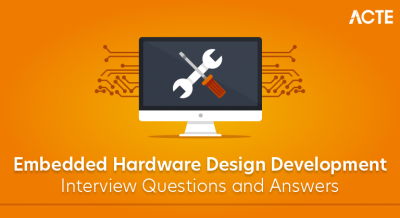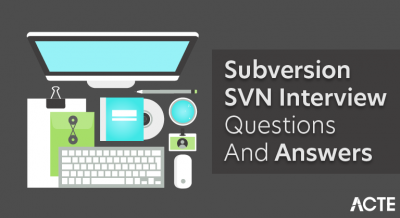
Git is a free and open source distributed version control system designed to handle everything from small to very large projects with speed and efficiency. Git is easy to learn and has a tiny footprint with lightning fast performance. It outclasses SCM tools like Subversion, CVS, Perforce, and ClearCase with features like cheap local branching, convenient staging areas, and multiple workflows.
1. What is Git,and how does it differ from the other version control systems?
Ans:
Git is the distributed version control system used to track changes in a source code during software development. It differs from the other version control systems like a Subversion and CVS in that it doesn’t rely on a central repository. Instead, every developer has full copy of the repository on local machine, allowing for a faster branching and merging.
2.What is the Staging area in Git?
Ans:
The Staging Area in Git is when it starts to track and save changes that occur in files. These saved changes reflect in .git directory. Staging is an intermediate area that helps to format and review the commits before their completion.
3. What are the advantages of using Git for software development?
Ans:
- Distributed development : Developers can work independently and merge changes later.
- Easy branching and merging : Branching and merging in Git is a fast and efficient, allowing developers to an experiment with different features and easily incorporate changes into main codebase.
- Version control : Git tracks every change made to codebase, making it easy to roll back to the previous version if needed.
- Open source : Git is an open source, meaning that anyone can contribute to its development and use it for free.
4. What is the Git workflow, and how does it work?
Ans:
The Git workflow is the series of steps that developers follow to make changes to codebase. It typically involves the creating a branch, making changes, committing those changes, and then merging a branch back into main codebase. The workflow can be customized to fit needs of a specific project, but basic idea remains the same.The Git workflow is the series of steps that developers follow to make changes to codebase. It typically involves the creating a branch, making changes, committing those changes, and then merging a branch back into main codebase. The workflow can be customized to fit needs of a specific project, but basic idea remains the same.
5. What is commit in Git, and how is it used ?
Ans:
A commit in Git is the snapshot of changes made to a codebase. It is used to track changes, roll back to the previous version, and collaborate with other developers. Each commit has unique identifier and commit message, which describes the changes made in that commit.
6. Why does not call git “pull request” as “push request” ?
Ans:
“Push request” is termed so because it is done when a target repository requests us to push changes to it.“Pull request” is named as such due to fact that the repo requests a target repository to grab (or pull) the changes from it.
7. What is the branch in Git,and how does it work?
Ans:
A branch in Git is the separate version of codebase that allows the developers to experiment with the new features or make changes without affecting the main codebase. Branches can be merged back into main codebase when the changes are ready.
8.What is remote in Git, and how does it work?
Ans:
A remote in Git is the copy of the repository that is stored on the different server. It allows the developers to collaborate with the other team members and pull changes made to a codebase.
9.What does merge in Git, and how does it work?
Ans:
A merge in Git is a process of combining changes from the one branch into another. It is used to incorporate the changes made by the multiple developers into the main codebase.
10. What is the conflict?
Ans:
Git usually handles the feature merges automatically but sometimes while working in the team environment, there might be cases of conflicts such as:
- When two separate branches have changes to a same line in a file
- A file is deleted in a one branch but has been modified in other.
11. What is pull request in Git,and how is it used ?
Ans:
A pull request in Git is the way for developers to submit changes to main codebase. It allows the other team members to review the changes before they are merged into codebase.
12.What does fork in Git, and how does different from a clone?
Ans:
A fork in Git is the copy of a repository that is stored on different user’s account. It allows the developers to make changes to codebase without affecting the original repository. A clone, on other hand, is a copy of repository stored on a same user’s machine.
13. How does one create a new repository in Git?
Ans:
To create the new repository in Git, follow these steps:
- Open a command line or terminal on your computer.
- Navigate to directory where want to create the repository.
- Run command git init.
- New Git repository is now initialized in directory.
14.How do I add files to Git repository ?
Ans:
To add the files to Git repository, follow these steps :
- Open a command line or terminal on computer.
- Navigate to directory containing the files want to add.
- Run command git add filename for each file want to add, replacing “filename” with actual name of the file.
- Alternatively, can use the command git add . to add all files in a current directory and its subdirectories.
15.How do I remove files from Git repository?
Ans:
To remove the files from Git repository, follow these steps:
- Open a command line or terminal on computer.
- Navigate to directory containing the files need to remove.
- Run the command git rm filename for each file want to remove, replacing “filename” with the actual name of file.
- Alternatively, can use the command git rm -r directory name to remove the entire directory and its contents.
16. What is head in git and how many heads can be generated in a repository ?
Ans:
To rename the file in Git, follow these steps:
- Open command line or terminal on a computer.
- Navigate to the directory containing a file need to rename.
- Run command git mv old filename new filename, replacing old filename with the
- current name of file and new filename with new name need to give it.
17.How do I move a file in Git?
Ans:
To move the file in Git, follow these steps:
- Open the command line or terminal on computer.
- Navigate to directory containing the file need to move.
- Run command git mv filename new directory name/, replacing filename with the name of file and new directory name with the name of the directory need to move it to.
18.How do you view the history of Git repository?
Ans:
To view the history of Git repository, follow these steps:
- Open a command line or terminal on computer.
- Navigate to directory containing the Git repository.
- Run a command git log.
- The output will show the list of all commits, with the most recent commit at top.
19. How does revert to a previous commit in Git?
Ans:
To revert to the previous commit in Git, follow these steps:
- Open a command line or terminal onthe computer.
- Navigate to directory containing a Git repository.
- Run the command git log to find hash of the commit need to revert to.
- Run command git revert
, replacing “ ” with the hash of the commit need to revert to.
20.How does undo last commit in Git?
Ans:
To undo last commit in Git, follow these steps:
- Open command line or terminal on computer.
- Navigate to directory containing the Git repository.
- Run command git reset HEAD~.
- This will remove last commit and leave the changes in working directory.
21. How does one delete a branch in Git?
Ans:
To delete the branch in Git, follow these steps:
- Open command line or terminal on computer.
- Navigate to directory containing Git repository.
- Run a command git branch -d branch name, replacing “branch name” with the name of branch need to delete.
22. How does delete a tag in Git?
Ans:
To delete the tag in Git, follow these steps:
- Open command line or terminal on computer.
- Navigate to directory containing the Git repository.
- Run command git tag -d tagname, replacing “tagname” with the name of the tag need to delete.
23. What is the difference between Git fetch and Git pull?
Ans:
git fetch only downloads a new data from a remote repository but doesn’t integrate it with the local repository. And can review the changes with git diff and then decide to merge them with the git merge.git pull is the combination of git fetch and git merge, which downloads a new data from a remote repository and automatically merges it with local repository.
24.How does one create an alias in Git?
Ans:
To create the alias in Git, follow these steps:
- Open command line or terminal on computer.
- Run the command git config –global alias.aliasname “actual command”, replacing “aliasname” with name need to give the alias and “actual command” with the actual Git command need to shorten.
25. What is the difference between a remote and a local repository in Git?
Ans:
Local Repository :
A repository on the local machine where store the project’s code Allows to work on the project and version control offline Have complete control over repository and its history
Remote Repository :
A repository that is hosted on the remote server or service, such as GitHub or GitLab. Allows the multiple people to collaborate on a same project and share code changes even if they are geographically distributed. Multiple people can contribute to a same remote repository, and each contributor’s changes are tracked and merged together.
26. What does sub-module in Git, and how does it work?
Ans:
A sub-module in Git is a way to include a one repository as a subdirectory of another repository. This is useful when need to include a third-party library or another project in own project.To add sub-module, use a git submodule add command, which adds reference to the sub-module in main repository. When a clone the main repository, the sub-module is not an automatically included. Instead, use git submodule update command to download the sub-module and integrate it with main repository.
27.How does one check the status of a Git repository?
Ans:
To check status of a Git repository, follow these steps:
- Open command line or terminal on computer.
- Navigate to directory containing the Git repository.
- Run a command git status.
- The output will show you the status of all files in repository, indicating which ones have been modified, added, or deleted.
28.How does stash changes in Git?
Ans:
To stash changes in the Git, follow these steps:
- Open command line or terminal on computer.
- Navigate to directory containing a Git repository.
- Run command git stash.
- This will save the changes in a temporary location and revert for working directory to its previous state.
29. How does one apply a stash in Git?
Ans:
To apply the stash in Git, follow these steps:
- Open command line or terminal on computer.
- Navigate to directory containing the Git repository.
- Run command git stash apply.
- This will apply the most recent stash to the working directory.
30. How do you unstash changes in Git?
Ans:
- Open command line or terminal on computer.
- Navigate to directory containing a Git repository.
- Run command git stash list to see a list of all stashes.
- Run command git stash and apply stash@{n}, replacing “n” with the index number of the stash need to unstash.
- This will apply the specified stash to working directory. If need to remove the stash after applying it, use a git stash drop stash@{n}.
31. What is the difference between Git and a file-sharing service like Dropbox or Google Drive?
Ans:
Git :
Designed specifically for a version control and collaboration on code Allows for granular control over the changes and version history Supports the branching and merging workflows, which enable multiple contributors to work on a same codebase simultaneously Code is stored in the repository, which maintains a complete history of changes to codebase.
File-Sharing Services (e.g. Dropbox, Google Drive) :
Designed primarily for a file sharing and collaboration on documents Limited version control and change the tracking capabilities Limited collaboration features and typically only allows the one user to edit file at a time.
32.How does cherry-pick a commit in Git?
Ans:
To cherry-pick commit in Git, can use the “git cherry-pick” command followed by a hash of the commit need to cherry-pick. This command applies the changes made by specified commit to a current branch.
33. What does rebasing in Git, and how does it work?
Ans:
Rebasing in Git is a process of changing the base of a branch from a one commit to another. This is typically done to incorporate changes from a one branch into another. The “git rebase” command is used for the rebasing, and it works by taking the changes made on one branch and applying them on top of the another branch.
34. How does one create a pull request on GitHub?
Ans:
To create a pull request on the GitHub, navigate to the repository’s page, click on the “Pull requests” tab, and then click on “New pull request” button. From there, can select the base and compare branches, add a description and any necessary files, and then submit a pull request.
35.What is Bitbucket, and how is it different from Git, GitHub, and GitLab?
Ans:
Bitbucket is the another web-based platform for hosting the Git repositories, similar to GitHub and GitLab. However, Bitbucket is owned by an Atlassian and is focused primarily on providing the solution for software teams. Bitbucket provides the features like Jira integration, code reviews, and access controls.
36.What is the difference between Git and SVN?
Ans:
Git and SVN are both version control systems, but they have a some fundamental differences. Git is the distributed version control system, which means that every developer has a copy of entire repository on their local machine. SVN isthe centralized version control system, which means that there is single repository that all the developers access remotely. Git also provides a better branching and merging capabilities compared to SVN.
37.How does clone a specific branch in Git?
Ans:
To clone the specific branch in Git, can use the “git clone” command followed by a repository’s URL and the “-b” option followed by branch name. For example, “git clone
38. Git vs. Maven/Gradle: distinctions in roles and functions?
Ans:
| Aspect | Git | Maven/Gradle | |
| Primary Purpose |
Version control syste |
Build automation tools | |
| Functionality | Tracks changes in source code | Manages build lifecycle, dependencies, etc. | |
| Dependency Management | N/A | Handles dependency resolution and management | |
| Workflow | Branching,committing,merging | Define project structure, build tasks,etc. |
39. How does one create a new repository on GitHub?
Ans:
To create the new repository on GitHub, can navigate to the profile page, click on the “Repositories” tab, and then click on “New” button. From there, can enter the repository name, add a description, and choose whether to make a repository public or private.
40. How does one create a new repository on GitLab?
Ans:
To create new repository on GitLab, follow these steps:
- Log in to GitLab account and navigate to a dashboard.
- Click on “New Project” button in top right corner.
- Choose the project name, description, and visibility level.
- Select the project template, if applicable.
- Click on Create project button to create new repository.
41. How does one create a new repository on Bitbucket?
Ans:
To create the new repository on Bitbucket, follow these steps:
- Log in to the Bitbucket account and navigate to dashboard.
- Click on +button on left side navigation bar.
- Choose “Repository” from a dropdown menu.
- Choose the project name, description, and visibility level.
- Select the repository template, if applicable.
- Click on “Create repository” button to create a new repository.
42.How do I add collaborators to a Git repository?
Ans:
To add the collaborators to a Git repository, follow these steps:
- Navigate to repository on Git hosting platform (e.g. GitHub, GitLab, Bitbucket).
- Click on “Settings” tab and select “Collaborators” or “Access Management”.
- Enter username or email address of collaborator need to add.
- Choose appropriate permission level for collaborator (e.g. read-only, read/write).
- Click on “Add collaborator” button to invite a collaborator to the repository.
- The collaborator will receive invitation email and will need to accept it to gain access to repository.
43.How does one remove collaborators from Git repository?
Ans:
To remove the collaborators from Git repository, follow these steps:
- Navigate to repository on Git hosting platform (e.g. GitHub, GitLab, Bitbucket).
- Click on the Settings tab and select Collaboratorsor Access Management.
- Find the collaborator need to remove and click on “Remove” or “Delete” button next to their name.
- Confirm that need to remove the collaborator.
44. How does one configure Git on local machine?
Ans:
To configure Git on the local machine, follow these steps:
- Install Git on machine if haven’t already.
- Open terminal or command prompt window.
- Set a username and email address using “git config” command.
- Set the preferred text editor for Git using “git config” command.
- Optionally, set the other global Git settings like aliases, colors, and credentials
45.What is Git hook, and how does it work?
Ans:
A Git hook is the script that is executed automatically at certain points in a Git workflow, such as before or after a commit, push, or merge operation. Git hooks can be used to automate a tasks such as running tests, formatting code, enforcing coding standards, or triggering notifications. Git hooks are stored in “.git/hooks” directory of a Git repository and can be customized by the developers to suit their specific needs.
46. How does one configure a pre-commit hook in Git?
Ans:
To configure the pre-commit hook in Git, follow these steps :
- Navigate to “.git/hooks” directory of your Git repository.
- Create the new file named “pre-commit” (without any file extension).
- Add shell script or command that need to run before each commit to “pre-commit” file.
- Make the “pre-commit” file executable by running command “chmod +x pre-commit”.
47.How does one configure a post-commit hook in Git?
Ans:
To configure the post-commit hook in Git, follow these steps :
- Navigate to git/hooks directory of a Git repository.
- Create the new file named “post-commit” (without any file extension).
- Add shell script or command that need to run after each commit to “post-commit” file.
- Make “post-commit” file executable by running a command “chmod +x post-commit”.
48. How does configure a pre-push hook in Git ?
Ans:
To configure the pre-push hook in Git, follow these steps :
- Navigate to git/hooks directory of Git repository.
- Create the new file named “pre-push” (without any file extension).
- Add shell script or command that need to run before each push to “pre-push” file.
- Make the “pre-push” file executable by running command “chmod +x pre-push”.
49. How does one move a repository to new location in Git?
Ans:
Can move the repository to a new location in Git by using a git clone –mirror command to clone repository, then updating the origin URL to a new location with the git remote set-url command, and finally pushing changes to the new location with git push –mirror command.
50. How does search Git commit history?
Ans:
Can search the Git commit history by using a git log command with –grep flag and a search string. For example, git log –grep=”bug fix” will search for commits with string “bug fix” in a commit message.
51. What is the difference between Git and TFS ?
Ans:
Git is the distributed version control system that allows for an offline work and branching and merging workflows,TFS (Team Foundation Server) is the centralized version control system that requires the connection to a central server and has less flexible workflow.
52. How does one create a tag in Git?
Ans:
Can create a tag in Git with git tag command followed by a tag name. For example, git tag v1.0 will create the tag called “v1.0” at current commit. And can also add a message to tag with the -a flag and edit the tag with -e flag.
53. How does revert specific file to previous commit in Git?
Ans:
Can revert specific file to the previous commit in Git with the git checkout command followed by a commit hash and file name. For example, git checkout abc123 file.txt will revert a file “file.txt” to the version in the commit “abc123”.
54.What is the difference between a fork and clone in Git?
Ans:
Fork :
Creates the new copy of remote repository under own account Allows to make changes to a codebase without affecting an original repository Typically used for the contributing to open-source projects or collaborating with the others Creates the new repository with new URL
Clone :
Makes the local copy of an existing repository on own machine Allows to work on codebase locally, but changes must be pushed to an original repository to be shared Typically used for a personal development or collaboration within team Creates the local copy of an existing repository with the same URL as original repository
55.How does cherry-pick multiple commits in Git?
Ans:
Can cherry-pick multiple commits in a Git by using the git cherry-pick command followed by the range of commits. For example, git cherry-picks abc123..def456 will cherry-pick all commits between “abc123” and “def456”.
56.How does add remote to Git repository?
Ans:
Can add a remote to the Git repository with the git remote add command followed by a remote name and URL. For example, a git remote add origin will add remote called origin with the URL .
57.What is a detached head?
Ans:
A detached HEAD is the state where the HEAD pointer is not pointing to a current commit. This can happen if check out a commit that is not the most recent, or if reset the head to the previous commit.
58.What is commit message?
Ans:
A commit message is the brief description of the changes made to the codebase or project. It is the message that is associated with the specific commit in a version control system like Git. It helps to other developers understand what changes were made and why.
59. How does one fix broken commit?
Ans:
To fix broken commit, can use the Git command git commit –amend. This command allows to modify the most recent commit in the Git history. And can add, remove, or modify files in commit, as well as change a commit message.
60. What is the difference between commit and branch in Git?
Ans:
Commit :
- Represents the specific change or snapshot of the codebase
- Is single point in a Git history
- Contains the unique identifier (hash) that represents the commit’s contents.
- Cannot be modified once it has been made.
- Is used to track changes made to a codebase over time
Branch :
- Represents the separate line of development
- Can have the multiple commits associated with it.
- Contains the unique identifier (hash) that represents the branch’s contents Can be modified, merged, or deleted as be needed.
- Is used to allow the multiple developers to work on same codebase simultaneously.
61.What is a repository in Git ?
Ans:
A repository in Git is the collection of files and directories that are managed using the Git version control system. It stores complete history of changes made to the files in repository, allowing developers to track changes and a collaborate on projects.
62.How does Git different from a backup solution like Time Machine or Carbonite?
Ans:
Git :
- Designed for a version control and managing code changes.
- Tracks changes and allows for a versioning of code files.
- Provides the way to revert changes or recover from errors.
- Works best with the plain text files and source code.
Backup solutions :
- Designed for a backing up files and data.
- May not track changes or provide a versioning of files.
- May not provide the way to recover from an errors or revert changes.
- Works well with the wide variety of file types.
- May be easier to use and need less technical knowledge.
What is ‘conflict’ in git?
Ans:
A conflict in Git occurs when two or more developers modify a same file or lines of code in the file, and then try to merge their changes together. Git is unable to automatically resolve differences and requires a manual intervention to resolve the conflict.
64.How is git instaweb used??
Ans:
Git instaweb is the command that launches the local web server that allows to browse a Git repository using the web browser. can use it by running git instaweb command in the repository.
65.What is git is-tree?
Ans:
Git ls-tree is the Git command that displays information about contents of the Git repository. It can be used to list the files and directories in the specific Git tree object.
66.What is SubGit?
Ans:
SubGit is the tool that allows to synchronize a Git repository with the Subversion repository. It enables the bi-directional synchronization, so that changes made in either repository are automatically reflected in other.
67.What does work restored when t deleted branch is recovered?
Ans:
When the deleted branch is recovered, all of the work that was committed to a branch up until the point of deletion is restored. This includes all of the commits, files, and changes that are made on the branch.
68. What is git stash?
Ans:
Git stash is the command in Git that allows to temporarily save changes that are not yet ready to be committed. It stores these changes in “stash” and allows to retrieve them later.
69. What does the function of ‘git stash apply’?
Ans:
Git stash apply is the Git command that applies the most recent stash to working directory. It allows to retrieve the changes that are stored in the stash and apply them to the current branch.
70. What is git stash drop?
Ans:
Git stash drop is the Git command that deletes the most recent stash from the repository. It permanently removes saved changes from a stash and cannot be undone.
71. What is the function of ‘git config’?
Ans:
Git config is the Git command that allows to configure the various settings in the Git repository. And can use it to set a name and email address, configure aliases, and adjust the other options related to the Git behavior.
72. What does ‘hooks’ comprise of in Git?
Ans:
In Git, “hooks” are scripts that are executed automatically when certain Git events occur, such as commit, a push, or a merge. They allow to automate tasks or enforce policies in the Git workflow.
73. How will you push the committed source code to the server?
Ans:
To configure the Git repository to run code sanity-checking tools before making commits, can use Git’s “pre-commit” hook. Here are steps:
- Create file named pre-commit in git/hooks directory of Git repository.
- Make a file executable by running command “chmod +x .git/hooks/pre-commit”.
- Add the code to run a code sanity-checking tool and return error code if tests fail.
- Save the file.
74. How do Git and GitHub differ in terms of functionality, collaboration, and access control?
Ans:
| Aspect | Git | GitHub |
| Definition |
Distributed version control system |
Web-based platform for Git repositories |
| Functionality | Manages version control locally | Extends Git with collaboration features |
| Location | Hardware acceleration | Operates locally on a machine |
| Collaboration | Supports collaboration with limitations | Facilitates collaboration with pull requests, issues, etc. |
75. How does Git different from other version control systems like SVN or Mercurial?
Ans:
Git :
- Distributed architecture where every developer has a full copy of repository.
- Uses hashes to identify the changes, making it simpler to track changes and recover from an errors.
- Provides the staging area for selecting changes to be committed, allowing for a more granular control over commits.
SVN/Mercurial :
- Centralized architecture where all the code changes are committed to the central repository.
- Uses the sequential revision numbers to identify changes, which can make it difficult to track changes and recover from an errors.
- Does not provide the staging area, requiring all changes to be committed together.
76. What is the functionality of git ls-tree?
Ans:
This command returns the tree object representation of a current repository along with the mode and the name of each item and the SHA-1 value of a blob.
77. What does git status command do?
Ans:
Git status command is used for showing the difference between working directory and the index which is helpful for understanding git in-depth and also keeping track of tracked and a non-tracked changes.
78. Why does require branching in GIT?
Ans:
With the help of branching, can keep the branch, and can also jump between the different branches. And can go to the past work while at a same time keeping the recent work intact.
79. What is the version control system (VCS)?
Ans:
A VCS keeps track of contributions of the developers working as team on projects. They maintain the history of code changes done and with the project evolution, it gives an upper hand to developers to introduce a new code, fix bugs, and run tests with the confidence that their previously working copy could be restored at any moment in the case things go wrong.
80.What does git pull origin?
Ans:
Pull is the get and consolidation. ‘git pull origin master’ brings submits from a master branch of the source remote (into the local origin/master branch), and then it combines the origin/master into branch currently have looked out.
81. What does git commit?
Ans:
Git commits records changes to storehouse while git push updates a remote refs along with the contained objects So first one is used in network with the local repository, while latter one is used to communicate with remote repository.
- git commit -m “First release of Hello World!”
- [master (root-commit) 221ec6e] First release of Hello World!
- 3 files changed, 26 insertions(+)
- create mode 100644 README.md
- create mode 100644 bluestyle.css
- create mode 100644 index.html
82. How does one fix a messed-up submission?
Ans:
To fix the any messed up commit, will utilize the order git commit? correct. By running in this direction, And can set wrecked commit message in the editor.
83.Mention various Git repository hosting functions?
Ans:
- Pikacode
- Visual Studio Online
- GitHub
- GitEnterprise
- SourceForge.net.
84. Mention some of best graphical GIT customers for LINUX? Explain them.
Ans:
- Git Cola
- Smart git
- Git-g
- Git GUI
- Giggle
- quit.
85.Why does use Subgit?
Ans:
- It is much superior to the git-svn.,
- No need to change infrastructure that is already placed.
- It allows using all the git and all the sub-version features.
- It provides the stress-free migration experience.
86. What language is used in Git?
Ans:
Git is the fast and reliable version control system, and language that makes this possible is ‘C.’ Using C language reduces overhead of run times, which are common in the high-level language.
87. How does resolve conflicts in Git?
Ans:
- Identify the files responsible for conflicts.
- Implement desired changes to files.
- Add the files using a git add command.
- The last step is to commit changes in the file with the help of git commit command.
88. What do you mean by topic branches?
Ans:
The Git Bisect command performs the binary search to detect commit which introduced a bug or regression in a project’s history.
Syntax: git bisect.
89. Why does considered to be easy to work on Git?
Ans:
- It has straightforward learning curve. Even those new to the programming can easily learn how to use Git with just few hours of practice.
- Git is highly flexible and can be easily customized to fit tneeds of any project.
- And, Git is more stable and reliable, so users can trust that work will be safe and sound.
90.What is Git reflog?
Ans:
Git reflog is the history of all the changes made to git repository. It is a valuable tool for a debugging and troubleshooting purposes. And Git reflog can be used to view history of a repository, see who made what changes, and when those changes are made.
91.What is the difference between Git and build automation tool like Maven or Gradle?
Ans:
Git :
Designed for a version control and managing code changes Tracks changes and allows for versioning of a code files Provides the branching and merging for parallel development efforts Supports the collaboration among multiple developers Requires the working knowledge of command-line or GUI tools for use.
Build automation tools :
Designed for an automating build process for software projects Does not track changes or version code files May not provide the branching or merging features May not be designed for the collaboration.
92. What is the difference between Git and GitHub?
Ans:
Git :
- A version control system used to track the changes in files and manage projects
- Developed by the Linus Torvalds in 2005
- An Open-source and free to use.
- A Command-line interface (CLI) tool.
GitHub :
- A web-based platform used for the hosting, sharing, and collaborating on a Git repositories.
- Developed by the Chris Wanstrath, PJ Hyett, and Tom Preston-Werner in 2008.
- Offers for both free and paid plans, depending on usage and features
- A Web-based user interface (UI) in addition to CLI tool.




